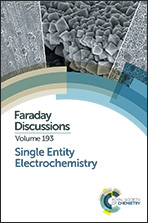Mechanistic aspects of hydrazine-induced Pt colloid instability and monitoring aggregation kinetics with nanoparticle impact electroanalysis
Abstract
Here we investigate the mechanistic aspects of Pt nanoparticle (NP) aggregation in solutions typically used for detecting NP/electrode impacts by electrocatalytic amplification (ECA). We previously proposed a general mechanism for Pt colloid destabilization that involved the participation of both the hydrazine redox probe and the pH buffer species as coagulants. Herein the Pt NP coagulation and aggregation mechanisms were further investigated with microscopic kinetic NP concentration monitoring and zeta potential measurements using nanoparticle tracking analysis (NTA), as well as open circuit potential experiments with a citrate-treated polycrystalline Pt surface to assess electrical double layer potential. After considering the combined results of these experiments we propose that the colloidal stability of citrate-capped platinum nanoparticles involves much more than the typical physicochemical interactions predicted by DLVO theory. A structure based on intermolecular H-bonding in the citrate capping layer is the most plausible explanation for the exceptional stability of large Pt NPs in high ionic strength buffers. Thus, the mechanism of Pt NP aggregation includes specific reactive contributions from hydrazine. The catalytic decomposition of hydrazine, in particular, is thought to occur to some extent at the citrate-coated Pt surface while the citrate remains adsorbed. Evolved gases such as ammonia and possible surface bound intermediates from Pt-catalyzed decomposition of hydrazine may disrupt the stability of the citrate layer, causing colloidal instability and thus promoting Pt NP coagulation. In the closing section, we demonstrate nanoparticle impact electroanalysis by ECA detection as a method to quantify Pt NP concentration with adequate time resolution for monitoring the kinetics of Pt NP coagulation.
- This article is part of the themed collection: Single Entity Electrochemistry

 Please wait while we load your content...
Please wait while we load your content...